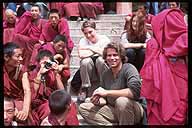This peace sign was the earliest graphic for Critical Graphics which I designed completely from scratch in Photoshop. I've gotta learn Illustrator, for which something like this would be a relative snap. With Photoshop it was pretty arduous and as late as 2006 I was still finding the occasional flaw.
The original idea began with the Christian Right's moral objectivism, the idea that so-called traditional moral values (read Christian moral values) form the basis of righteous standards for behaviour and belief. Paah. Particularly when these same religious conservatives backed policies of war, terror and murder.
I enjoy turning such hypocrisies upon themselves. If Jesus Christ, the Prince of Peace, stood for any one moral value above all it was peace itself. And, so was born the synthesis of the mighty peace symbol and the catch-phrase, "Traditional Moral Value." It was quite popular for a while but has since been eclipsed by other peace sign designs. The Emphatic Peace design above, with the "Peace" caption added for emphasis remains one of the most popular images on Critical Graphics.
A little bit about the peace sign from Wikipedia...
The peace symbol
This forked symbol was adopted as its badge by the Campaign for Nuclear Disarmament in Britain, and originally, its use was confined to supporters of that organization. It was later generalised to become an icon of the 1960s anti-war movement, and was also adopted by the counterculture of the time. It was designed and completed February 21, 1958 by Gerald Holtom, a commercial designer and artist in Britain. He had been commissioned by the CND to design a symbol for use at an Easter march to Canterbury Cathedral in protest against the Atomic Weapons Research Establishment at Aldermaston in England.
The symbol itself is a combination of the semaphoric signals for the letters "N" and "D," standing for Nuclear Disarmament. In semaphore the letter "N" is formed by a person holding two flags in an upside-down "V," and the letter "D" is formed by holding one flag pointed straight up and the other pointed straight down. These two signals imposed over each other form the shape of the peace symbol. In the original design the lines widened at the edge of the circle.
A conscientious objector who had worked on a farm in Norfolk during the Second World War, Holtom later wrote to Hugh Brock, editor of Peace News, explaining the genesis of his idea in greater depth: "I was in despair. Deep despair. I drew myself: the representative of an individual in despair, with hands palm outstretched outwards and downwards in the manner of Goya’s peasant before the firing squad. I formalised the drawing into a line and put a circle round it."[1]

The peace symbol flag first became known in the United States in 1958 when Albert Bigelow, a pacifist protester, sailed his small boat outfitted with the CND banner into the vicinity of a nuclear test. The peace symbol button was imported into the United States in 1960 by Philip Altbach, a freshman at the University of Chicago, who traveled to England to meet with British peace groups as a delegate from the Student Peace Union (SPU). Altbach purchased a bag of the "chickentrack" buttons while he was in England, and brought them back to Chicago, where he convinced SPU to reprint the button and adopt it as its symbol. Over the next four years, SPU reproduced and sold thousands of the buttons on college campuses.
In Unicode, the peace symbol is U+262E: ☮, and can thus be generated in HTML by typing ☮ or ☮. However, many browsers will not have a font that can display it.
Antagonism
The fact that the symbol resembles a bird foot in a circle gave rise to spurious alternative interpretations, ranging from plain mockery of "crow's foot" or "The footprint of the American Chicken" (suggesting that peace activists were cowards) to a number of occult meanings, such as an upside down crucifix with the arms broken downward, suggesting the way that St. Peter was martyred. Others have claimed that the symbol resembles a medieval sign known as "Nero's Cross" that represents Satanism. Alternatively, some have suggested that the symbol is an inverted Elhaz rune, which would reverse the rune's meaning, according to the critics, from 'life' to 'death' (although the Elhaz rune is thought to mean elk[2]). As well, a commonly repeated conjecture during the 1960s was that it was an antichrist symbol: a representation Jesus on the cross upside-down. Gerald Holtom's explanation of the genesis of the symbol and his first drawings of it, however, do not support those interpretations.:) [3][4][5][6]
It uses material from the Wikipedia article Peace Symbol







No comments:
Post a Comment